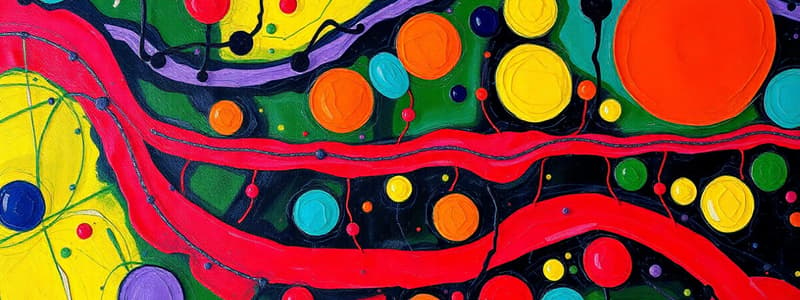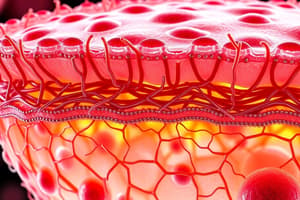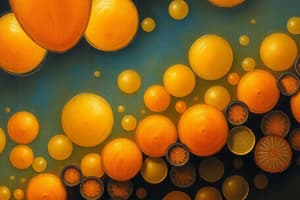Podcast
Questions and Answers
What is the primary location of glycoproteins and glycolipids within eukaryotic cells?
What is the primary location of glycoproteins and glycolipids within eukaryotic cells?
- Nucleus
- Cytoplasm
- Plasma membrane (correct)
- Golgi apparatus
Which of the following is NOT a function of glycoproteins in the cell membrane?
Which of the following is NOT a function of glycoproteins in the cell membrane?
- Protein synthesis (correct)
- Receptor activity
- Immune response
- Cell-cell adhesion
What is the main difference between N-linked and O-linked glycosylation?
What is the main difference between N-linked and O-linked glycosylation?
- The type of sugar molecule attached to the protein
- The location of the carbohydrate attachment on the protein (correct)
- The length of the carbohydrate chain
- The function of the glycoprotein
Which of the following is NOT a component of the extracellular matrix (ECM)?
Which of the following is NOT a component of the extracellular matrix (ECM)?
Which type of cell junction allows for direct communication between adjacent cells?
Which type of cell junction allows for direct communication between adjacent cells?
Which of the following is NOT a characteristic of lipid rafts?
Which of the following is NOT a characteristic of lipid rafts?
What is the main function of sterols in biological membranes?
What is the main function of sterols in biological membranes?
Which type of protein is NOT directly embedded within the membrane?
Which type of protein is NOT directly embedded within the membrane?
Which scientist(s) proposed the "sandwich" model of the cell membrane, consisting of a lipid bilayer sandwiched between protein sheets?
Which scientist(s) proposed the "sandwich" model of the cell membrane, consisting of a lipid bilayer sandwiched between protein sheets?
Which of the following is NOT a function of membrane proteins?
Which of the following is NOT a function of membrane proteins?
What is the primary function of cholesterol in the cell membrane?
What is the primary function of cholesterol in the cell membrane?
Which of these is NOT a function of the cell membrane?
Which of these is NOT a function of the cell membrane?
What is the role of cholesterol in lipid rafts?
What is the role of cholesterol in lipid rafts?
What is the significance of the 'fluid mosaic' model proposed by Singer and Nicolson?
What is the significance of the 'fluid mosaic' model proposed by Singer and Nicolson?
What is the approximate thickness of a cell membrane?
What is the approximate thickness of a cell membrane?
What is the primary characteristic of integral proteins that distinguishes them from peripheral proteins?
What is the primary characteristic of integral proteins that distinguishes them from peripheral proteins?
What type of membrane protein is characterized by its covalent bond to saturated fatty acids or an isoprenyl group?
What type of membrane protein is characterized by its covalent bond to saturated fatty acids or an isoprenyl group?
Which of the following types of bonds is the strongest when disrupting molecular forces in proteins?
Which of the following types of bonds is the strongest when disrupting molecular forces in proteins?
Which property of membrane proteins is influenced by temperature changes?
Which property of membrane proteins is influenced by temperature changes?
What structural feature do transmembrane segments of integral proteins often have?
What structural feature do transmembrane segments of integral proteins often have?
How do peripheral proteins primarily associate with membranes?
How do peripheral proteins primarily associate with membranes?
In what way do membrane protein complexes contribute to cellular functions?
In what way do membrane protein complexes contribute to cellular functions?
Which of the following statements is true about protein movements within the membrane?
Which of the following statements is true about protein movements within the membrane?
What is the effect of increasing the concentration of saturated fatty acids in a membrane?
What is the effect of increasing the concentration of saturated fatty acids in a membrane?
Which of the following is NOT a characteristic of phospholipids?
Which of the following is NOT a characteristic of phospholipids?
How does cholesterol affect membrane fluidity?
How does cholesterol affect membrane fluidity?
What is the role of lipid rafts in the cell membrane?
What is the role of lipid rafts in the cell membrane?
What is the primary location of cholesterol in a eukaryotic cell?
What is the primary location of cholesterol in a eukaryotic cell?
Which of the following statements about the physical characteristics of lipid bilayers is TRUE?
Which of the following statements about the physical characteristics of lipid bilayers is TRUE?
What is the effect of increasing temperature on the membrane fluidity?
What is the effect of increasing temperature on the membrane fluidity?
Which of the following is NOT a feature of lipid bilayers?
Which of the following is NOT a feature of lipid bilayers?
Which of the following factors influences the fluidity of a lipid bilayer?
Which of the following factors influences the fluidity of a lipid bilayer?
Why is it important for biological membranes to be fluid?
Why is it important for biological membranes to be fluid?
Flashcards
Tm (Transition Temperature)
Tm (Transition Temperature)
The temperature at which membrane fluidity changes significantly.
Lipid Rafts
Lipid Rafts
Dynamic microdomains in membranes, thicker and less fluid, rich in cholesterol and saturated lipids.
Function of Lipid Rafts
Function of Lipid Rafts
Involved in cholesterol transport, endocytosis, signal transduction, and sequestering proteins.
Integral Membrane Proteins
Integral Membrane Proteins
Signup and view all the flashcards
Peripheral Membrane Proteins
Peripheral Membrane Proteins
Signup and view all the flashcards
Glycoproteins
Glycoproteins
Signup and view all the flashcards
N-linked glycosylation
N-linked glycosylation
Signup and view all the flashcards
O-linked glycosylation
O-linked glycosylation
Signup and view all the flashcards
Glycolipids
Glycolipids
Signup and view all the flashcards
Cell adhesion
Cell adhesion
Signup and view all the flashcards
Phospholipids
Phospholipids
Signup and view all the flashcards
Amphipathic molecules
Amphipathic molecules
Signup and view all the flashcards
Phospholipid bilayer
Phospholipid bilayer
Signup and view all the flashcards
Fluidity of membranes
Fluidity of membranes
Signup and view all the flashcards
Saturation of fatty acids
Saturation of fatty acids
Signup and view all the flashcards
Cholesterol
Cholesterol
Signup and view all the flashcards
Temperature effect on fluidity
Temperature effect on fluidity
Signup and view all the flashcards
Self-healing of membranes
Self-healing of membranes
Signup and view all the flashcards
Cell Membrane
Cell Membrane
Signup and view all the flashcards
Fluid Mosaic Theory
Fluid Mosaic Theory
Signup and view all the flashcards
Membrane Lipids
Membrane Lipids
Signup and view all the flashcards
Integral Proteins
Integral Proteins
Signup and view all the flashcards
Transduction of signals
Transduction of signals
Signup and view all the flashcards
Covalent bond disruption
Covalent bond disruption
Signup and view all the flashcards
Peripheral proteins
Peripheral proteins
Signup and view all the flashcards
Lipid-anchored proteins
Lipid-anchored proteins
Signup and view all the flashcards
Protein movement in membranes
Protein movement in membranes
Signup and view all the flashcards
Protein complexes
Protein complexes
Signup and view all the flashcards
Membrane carbohydrates
Membrane carbohydrates
Signup and view all the flashcards
Study Notes
Biological Membrane
- Composed of cell structures (eukaryotic): cell membrane, nucleus, organelles, cytoplasm, mitochondria, and cytoskeleton.
- Cell membrane functions: separating the inside from the outside, maintaining concentration gradients, maintaining membrane potential, binding cells together, mediating and regulating cell transport, and detecting and transmitting electrical and chemical signals.
- Cell membrane theory evolution: Overton (1890s): lipid nature of biological membranes; Langmuir (1917): lipid monolayer (hydrophilic/hydrophobic surfaces); Gorter and Grendel (1925): lipid bilayer; Danielli and Davson (1935): lipid bilayer + protein sheets ("sandwich" model); Singer and Nicolson (1972): fluid-mosaic theory; Unwin and Henderson (1975): membrane proteins contain transmembrane segments; Recent Findings (2000): Lipid rafts.
- Cell membrane (7-10nm): fluid mosaic theory (Singer and Nicolson, 1972); membrane lipids (40%): bilayer, phospholipids (dominate the structure), cholesterol (provides stability); membrane proteins (52%): peripheral proteins (confined to the surface), integral proteins (span the membrane); and membrane carbohydrates (8%): glycoproteins, glycolipids.
Membrane Structure
- Phospholipids: amphipathic molecules (one water-soluble portion and one lipid-soluble portion) with hydrophilic head groups and hydrophobic hydrocarbon tails. Spontaneously aggregate into a bilayer in water, with phosphate head groups facing outward toward the aqueous environment inside and outside the cell.
- Cholesterol: stabilizes the membrane and changes its fluidity. Lipid rafts are aggregations of lipids and cholesterol.
Membrane Fluidity
- Decreased cholesterol decreases fluidity
- Decreased saturation (FA) increases fluidity
- Increased cholesterol increases saturation (FA) increases fluidity
- Decreased temperature decreases fluidity
- Increased temperature increases fluidity
- Length of fatty acids (FA) affects fluidity. Short-chain FA increases fluidity, and long-chain FA decreases fluidity.
- Degree of saturation of FA affects fluidity. Unsaturated FA increases fluidity, and saturated FA decreases fluidity.
Lipid Composition
- Phospholipids are the most abundant lipid component in cell membranes.
- Phosphoglycerides (glycerol-based) and sphingolipids (sphingosine-based) are two major classes.
- Sterols (e.g., cholesterol in animals, ergosterol in fungi) are present in some membranes and influence fluidity.
- Lipids are distributed unequally in two monolayers. Glycolipids are mostly on the outer layer.
Protein Composition
- Integral proteins: covalently attached to fatty acid chains in the hydrophobic interior and typically have hydrophobic transmembrane segments.
- Peripheral proteins: attached to exposed polar heads of membrane lipids or integral proteins by weak electrostatic forces and hydrogen bonds.
Lipid-Anchored Proteins
- GPI-anchored proteins: covalently attached to glycosylphosphatidylinositol (GPI).
Protein Movements
- Protein movement within the membrane may be lateral and rotational (more restricted than phospholipids).
Membrane Carbohydrates
- Carbohydrates are attached to proteins (glycoproteins) or lipids (glycolipids) by glycosylation.
Cell-Cell Adhesion
- Cells are connected through extracellular matrix (ECM) components (like collagen, elastin, and fibronectin).
- Specialized cell junctions include tight junctions, desmosomes, and gap junctions.
Studying That Suits You
Use AI to generate personalized quizzes and flashcards to suit your learning preferences.




